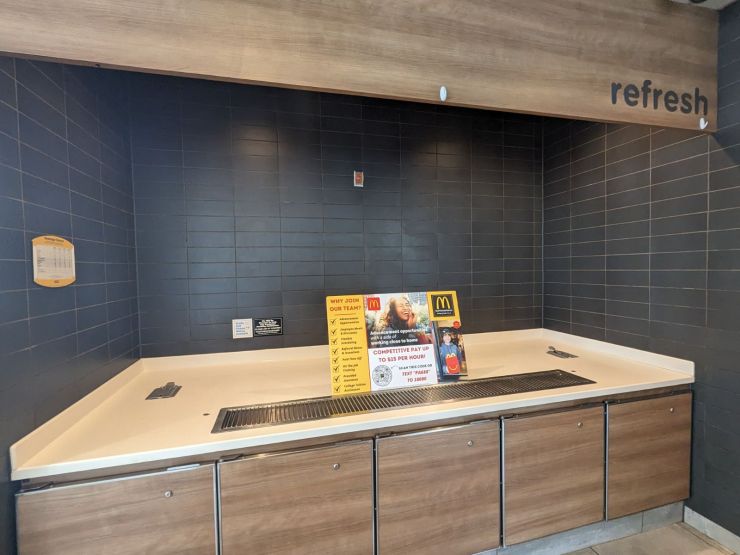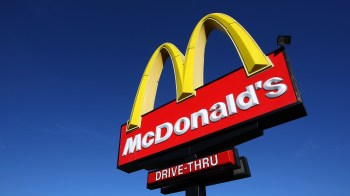
The days of free refills may be over

Twenty years after McDonald’s first introduced self-serve soda machines, the days of self-serve refills are now numbered.
McDonald’s will phase out its self-serve soda machines by 2032, a move that’s already underway at some stores, according to The Springfield State Journal-Register, an Illinois-based publication that first reported the decision.
Nathan Selkirk, an Uber Eats delivery driver, told Marketplace that he recently spotted a McDonald’s location in Pittsburgh, Pennsylvania, that no longer offered self-serve machines and charged customers for refills. Individual McDonald’s restaurants can decide whether or not to charge for beverage refills, a McDonald’s representative told the publication Insider.

Customers at other establishments, like Wegmans and Panera Bread, have also noticed that the self-serve machines at some locations have disappeared amid the pandemic. And some restaurants at mall food courts in Western New York and Pennsylvania have been putting their soda machines behind the counter, said Alex Susskind, a professor of food and beverage management at Cornell University.
It’s a move that experts say will likely become more widespread. “McDonald’s tends to be a leader in the industry. And very often, when they make big changes, other restaurants follow suit. McDonald’s is very smart about their costs,” said Darren Tristano, CEO of FoodserviceResults, a research and consulting firm for the food industry.
We reached out to McDonald’s, Wegmans and Panera Bread for comment, but did not receive comment by publication time.
McDonald’s launch of self-serve soda machines in 2004 allowed people to mix and match whatever concoctions they desired. “They did the math, and they figured, ‘Oh, it’s just easier for the guests to help themselves,” Susskind said.
But these days, guests aren’t dining in as much. The decision to move away from self-serve machines reflects the changing nature of how customers are buying their food — more are now getting take-out or going to the drive-through, said David Henkes, senior principal and head of strategic partnerships at Technomic, a food service research and consulting firm.
Consumers are also more concerned about germs and viruses in food service due to the COVID-19 pandemic, Tristano said. We saw during the early days of the pandemic how the coronavirus forced buffet owners to change their practices or shut down operations entirely.
And cleaning up these self-serve machines requires a lot of time and effort, Susskind pointed out.
“The amount of cleaning and upkeep that’s required for these guest-facing dispensers is pretty significant. The ice has to be replaced, you have to clean up the mess, you have to pick up the straw fragments,” Susskind said.
Restaurants might also be trying to save money, even though they pay very little for these drinks. The profit margins on soft drinks are high, ranging between 90% to 95% or more, Henkes said.
“It’s essentially pennies per drink for the cost of the syrup,” Henkes said. “It’s a good business, and that’s why a lot of times, you see companies doing any size for $1.”
But now, that second soda could now affect their pocketbooks in our changing economy. “Every penny is starting to matter, particularly in quick service,” Susskind said.
Susskind did some back-of-napkin calculations to explain what McDonald’s pays for extra drinks. The fast-food giant serves 25 million guests per day in the U.S. Now let’s say 20% of customers dine in, and 50% of those guests get a free refill. If McDonald’s pays 10 cents per beverage, that will cost the company $250,000 a day, Susskind said. That translates to more than $90 million a year.
“That is real money. All these figures are estimates, and they are significant in my opinion,” Susskind said.
In McDonald’s case, other factors playing a role include the possibility of theft, the amount of space these machines take up, and the restaurant’s new emphasis on a “relaxed dine-in experience,” which includes servers bringing meals to the table, according to The Springfield State Journal-Register.
As consumer prices rise, fast-food restaurants are grappling with the fall-out. While they had a strong first quarter in 2023, they’re failing to beat expectations this time around, Henkes said.
The cost of limited-service meals rose 5% over the past 12 months, according to the latest data from the Bureau of Labor Statistics. “Over the last 12-18 months, particularly with inflation, consumers are pulling back on their visits,” Henkes said.
Starbucks, Papa John’s, Pizza Hut and KFC recently reported declining same-store sales in their earnings report.
“I think the growth that you’re going to see in 2024 is going to be a lot more subdued than what we’ve seen the last couple of years. And a lot of that is because of a more cautious consumer,” Henkes said.
There’s a lot happening in the world. Through it all, Marketplace is here for you.
You rely on Marketplace to break down the world’s events and tell you how it affects you in a fact-based, approachable way. We rely on your financial support to keep making that possible.
Your donation today powers the independent journalism that you rely on. For just $5/month, you can help sustain Marketplace so we can keep reporting on the things that matter to you.

















